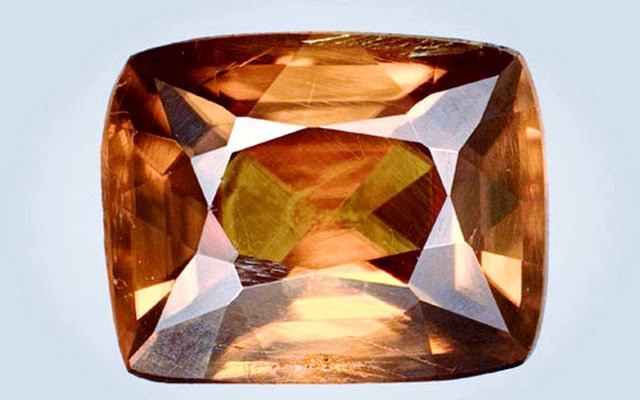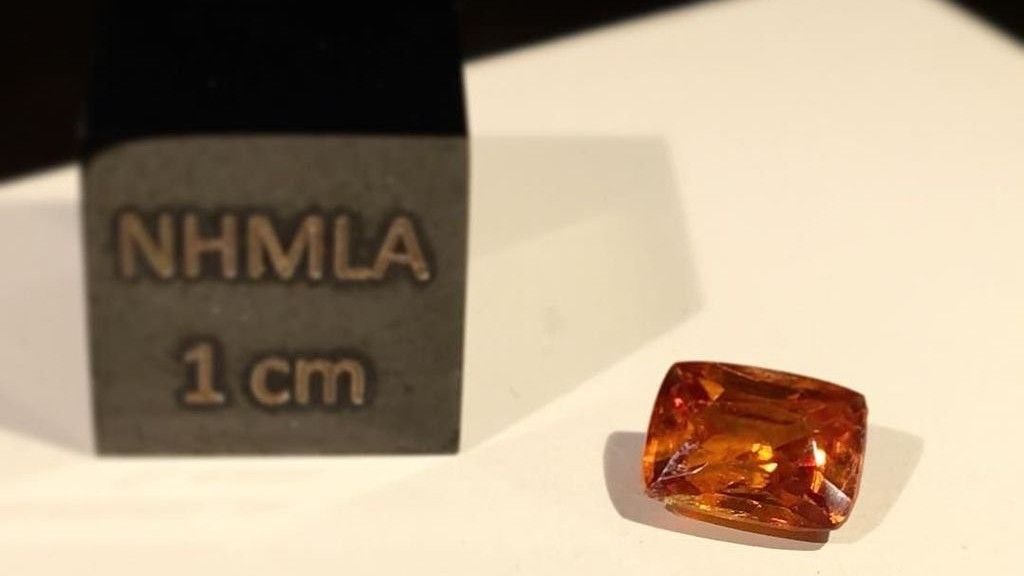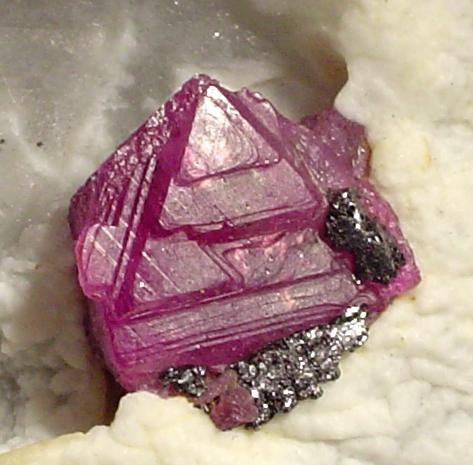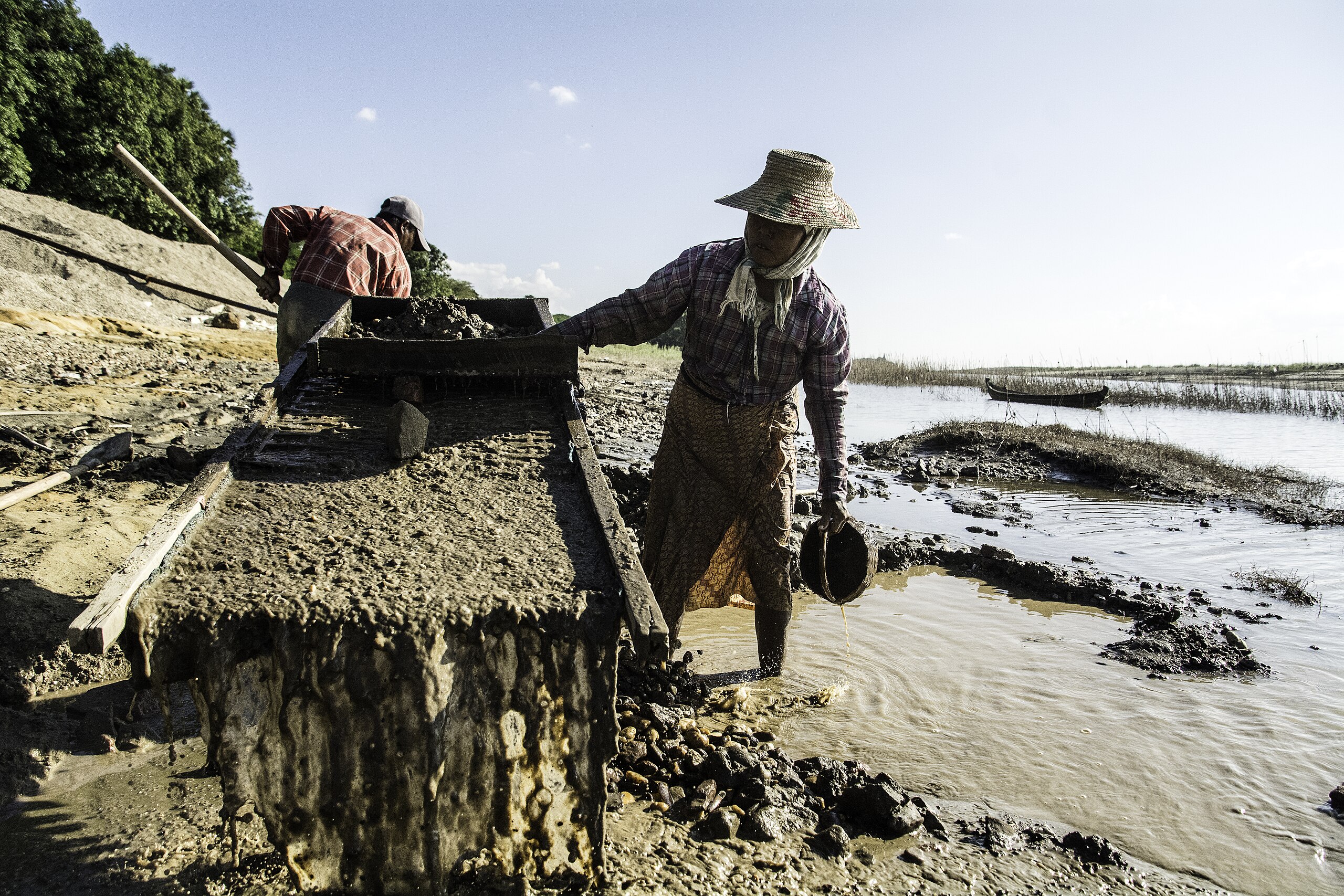
Credit: https://geologyin.com
Background
Synopsis: Kyawthuite is the rarest mineral on Earth—so rare that only one specimen has ever been found. This tiny, orangish-brown gemstone holds a mystery millions of years in the making, offering a glimpse into the hidden treasures of our planet.
- Imagine holding something in your hand that exists nowhere else on Earth except for this single piece. This is kyawthuite (cha-too-ite), the rarest mineral ever discovered. Unlike diamonds, sapphires, or even other rare gemstones, kyawthuite has only been found once in the entire world.
- Previous EarthDate episodes have described other minerals and gemstones (EarthDate episode 12—Your Most Ancient Possession; EarthDate episode 165—The Ever Green Stone), but nothing as rare as this.
- So, what makes this mineral so extraordinary, and why haven’t we found more?
- In 2010, miners were working in the Chaung-gyi Valley near Mogok, Myanmar, searching for precious sapphires and other gemstones. While sifting through the alluvium near a stream bed, they picked up a water-weathered crystal that they presumed was amber or topaz. This find and other gems were then taken to the Chaung-gyi market for sale.
- A Burmese mineralogist and gemologist, Dr. Kyaw Thu who is also the owner and operator of the Macle Gem Trade Laboratory, purchased the stone at the market later that year. He faceted the stone, resulting in a 1.61 carat orangish-brown gemstone.
- An extensive verification process using advanced analytic techniques confirmed that the specimen was indeed one-of-a-kind. Meticulous testing verified the unique chemical composition and crystal structure and in 2015, the International Mineralogical Association officially recognized the crystal as a unique specimen and named it kyawthuite after Dr. Thu.

The Natural History Museum of Los Angeles currently has the one specimen of kyawthuite on display.
Credit: https://drivingeco.com/en/kyawthuite-mineral-161-quilates-desafia-naturaleza/
- Kyawthuite is composed of a combination of bismuth and antimony oxides, resulting in a chemical formula of BiSbO4, a union that had never been observed in nature, adding to its rarity.
- An orderly arrangement of bismuth and antimony in a tetragonal structure creates a distinctive three-dimensional framework. This unique arrangement aids in distinguishing kyawthuite from other minerals with similar chemical compositions and creates novel physical properties.
- Minerals are often classified by their hardness using the Mohs hardness scale. Kyawthuite has a value of approximately 6.5 which means it could scratch materials like feldspar (hardness 6) but not quartz (hardness 7).
- Kyawthuite has a somewhat metallic sheen but is not as reflective as pure metals although it does have a bright appearance. This bright reflectivity and its orangish-brown color set it visually apart from other gems.
- With just one specimen of 1.61 carats, small enough to fit on a fingertip, more thorough studies cannot be conducted without damaging the stone.
- Myanmar’s Mogok Stone Tract is one of the most famous gem-producing regions in the world.
- Mogok, located in northern Myanmar greets visitors with a highway sign that reads “Welcome to Ruby Land.” As many as 1,000 working mines extract world-class gemstones including ruby, pink sapphire and spinels.
- George Harlow, curator of the American Museum of Natural History reflected on his first trip to Mogok in 1997–98 as a “jaw-dropping experience. I don’t know any other place on the entire planet that has such a diverse suite of minerals.”
- Political upheaval in the region restricted access to researchers for years, but scientists were finally able to explore the complex geology of the region in the early 2010’s as tension eased.
- The Mogok Stone Tract in Myanmar is rich with gemstones because it contains multiple geological environments that contribute to gem formation. Key factors include:
- Igneous intrusions (pegmatites)—Magma interacted with existing rock to form gemstones like sapphire and moonstone.
- Metamorphism—Heat, pressure and fluids transformed limestone into marble, creating rubies and spinels during mountain-building 200 million years ago.
- Weathering—Erosion concentrated gemstones in rivers and caverns, forming historically valuable deposits.
- Hot fluid circulation—Ancient hot water dissolved minerals and re-formed them in rock veins, possibly contributing to the corundum (ruby and sapphire) formation 25 to 15 million years ago.
- A combination of geological processes makes Mogok one of the world’s richest gemstone regions.

This 0.4 inch (1 cm) classic ruby crystal from Mogok contrasts beautifully with the white marble and lustrous scapolite crystals.
Credit: Robert M. Lavinsky, CC BY-SA 3.0, via Wikimedia Commons
A miner searches for gold in the Irrawaddy River which is the main river basin in Mogok.
Credit: Anton Gutmann, CC BY-SA 4.0, via Wikimedia Commons
- Minerals form through specific chemical and physical conditions including pressure, temperature and availability of key elements.
- Common minerals like quartz form easily because silica is abundant in Earth’s crust.
- Rare minerals like kyawthuite need a perfect storm of factors:
- Uncommon element combinations (bismuth is not a major component of most gem-forming regions)
- Precise temperature and pressure conditions
- The right amount of time and stability for crystallization
- If one factor is missing, the mineral won’t form or won’t survive long enough to be discovered.
- Many rare minerals form once in history with conditions never exactly the same again.
- Some minerals dissolve, transform or break down over geological time.
- Despite their scarcity, other rare gemstones such as the blue-colored grandidierite or red beryl still have many recognized specimens.
- Could more kyawthuite exist? Possibly, but it’s like finding a needle in a mountain of needles.
- Even in Myanmar, a world leader in rare gems, this mineral has only been found once.
- Scientists estimate over 5,000 minerals exist, but many remain undiscovered.
- The Earth’s crust is full of surprises with new minerals being identified every year.&
- Some minerals form only in extreme places such as deep-sea hydrothermal vents, meteorite impact zones and the Earth’s mantle which is too deep for us to explore directly.
- Studying rare minerals helps scientists understand Earth’s geological history.
- This one rare, precious stone currently resides in the Natural History Museum of Los Angeles County where kyawthuite remains a geological mystery and yet provides a small clue to the conditions that shaped our planet. Will more specimens ever be found? Perhaps, but the odds are low. Even in a world of billions, some things remain truly one-of-a-kind.
Episode script
What’s the rarest gemstone on Earth? Diamond? Ruby? Sapphire? Nope, none of these.
It’s kyawthuite.
The miners who discovered it thought nothing of it. This was in Myanmar, which produces a variety of gemstones: the Burmese ruby, sapphires, spinels, peridots and many others.
They’re recovered in several ways.
These miners were sifting through river gravel when they found a rough, rust-colored crystal they thought was topaz or amber. Nothing extraordinary, so they threw it in the basket to go to the local gem market.
There, Dr. Kyaw Thu, a gemologist, picked it up. It was heavier than most metals. And it had a slightly metallic sheen. He bought it for a few kyats and took it to his workshop.
There he began to study it—and found that it was a crystal compound of two rather rare metallic elements, bismuth and antimony. Surprised, he began to look for other specimens in the literature, and there were… none.
Not a single other specimen of this mineral had been identified anywhere on Earth, ever.
He submitted his finding to the International Mineralogical Association, who officially recognized it as one-of-a-kind—and named it after him: kyawthuite.
If you’d like to see it, the crystal now resides in the Los Angeles Natural History Museum.
What’s such a gemstone worth? Well, with no others to set a market value, it’s simply … priceless.

